Looking through the Skiascope: Benjamin Ives Gilman and the Invention of the Modern Museum Gallery
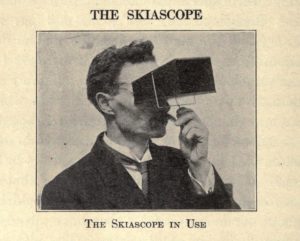
Late last summer, I visited the Rhode Island School of Design (RISD) Museum equipped with an odd device, a skiascope. I wanted to see art the way that Benjamin Ives Gilman (1852–1933) had seen it when he invented the device a century earlier. Gilman was a key player in the early twentieth-century debate over the proper way for museums to display art. He invented the skiascope to ensure that museum visitors saw art as he thought best—without distraction. I was working on the chapter in my forthcoming book, Inside the Lost Museum, that addressed the history of looking at art in museums, and so I decided to find a skiascope and give it a try. Unfortunately, as far as I was able to determine, no skiascope survives. And so I built one. I hoped that being able to look through it would allow me to understand Gilman better. It did.1
It also gave me new insight into the intellectual origins of the modern art museum. Gilman, secretary of the Museum of Fine Arts, Boston, from 1893 to 1925, was one of the most important museum theorists of the twentieth century. Indeed, Kathleen Curran, in her recent The Invention of the American Art Museum, suggests that the 1904 report, Communications to the Trustees Regarding the New Building, published by the Museum of Fine Arts, Boston, is “the birth certificate of the modern American art museum,” and singles out as its leitmotif Gilman’s phrase: “[Artistic comprehension] means that the mind rests in its object, simply and fully beholding it, without deserting it for any other interest whatever.”2
Over the following decades, art museums would be designed to ensure that visitors saw art in the way Gilman thought we should. Understanding his skiascope, which embodies in oak, wire, and flannel the ideals of the modern museum, reveals the roots of modern museum display.
The Sources of the Skiascope
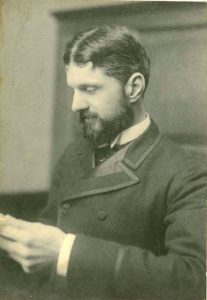
Gilman was born in New York in 1852, studied at Williams College, and then joined his family banking business. In 1881, he entered the PhD program in philosophy at Johns Hopkins University to study logic with Charles Sanders Pierce.3 How did Gilman get from math to museums? Through psychology. Philosophy in the 1880s included both mathematics and psychology, and Gilman left Johns Hopkins in 1882 to continue his graduate studies in the philosophy department at Harvard University, where he studied psychology with William James. Psychology was experiencing a moment of intellectual ferment, becoming an experimental science and an approach to philosophical questions.4
James saw Gilman as his protégé, and his letters provide a sense of Gilman’s interests and personality.5 After a visit to Gilman in New York, James wrote his wife expressing approval: “He is cosmopolitanized & broadened in look person & speech. But it is satisfactory to find so true, vigorous and definite a mind. His little book on Aesthetes will almost certainly be important and good.” He worried, though, about Gilman’s ability to complete his work. In an 1890 letter of recommendation to Charles Eliot, Harvard’s president, James wrote: “. . . a most accomplished man, whose only serious defect is lack of worldly ambition and a rather too high a standard of perfection in his work . . . . He has been for five years working at a book on Aestheticks [sic] treated in an experimental & psychological way, and he ought to be ready to publish but still postpones, in order to be more complete.”6
Gilman never published his book on aesthetics, but we can guess at what might have been in it, based on his other publications and his teaching, to get a sense of the science of psychology that Gilman would bring to his museum work.7 Gilman’s specialty was music. He undertook the first experimental attempts “ever made to reach exacter notions in regard to the expressiveness of music” by surveying listeners to classical music, attempting to understand “the power of music to awaken definite ideas and emotions in the listener.”8 This work is still cited as the origins of the field. While working at the Peabody Museum of Anthropology at Harvard University, Gilman made some of the first analyses of “primitive music” based on phonograph recordings, writing about Passamaquoddy, Zuni, and Hopi melodies. He visited the 1893 Columbian Exposition to record music of the Samoan, Turkish, Fijian, and Native peoples on display. Ethnomusicologists also count Gilman as one of the founders of their field.9
In the late 1880s, Gilman lectured on the psychology of music at Colorado College, Princeton, Harvard, and Columbia University. His approach combined science and art. “The purpose of this course,” his syllabus for Columbia announced, “is to inquire into the operations of the mind concerned in the hearing of music.” His lectures began with “the sensation of tone” and moved from science to the “general power [music has] over the soul”—from music to musician to listener.10
In 1892, Gilman was appointed an instructor in psychology at Clark University, Worcester, Massachusetts, where he offered a course on The Psychology of Pain and Pleasure. The syllabus for this course, some sixty pages of outline and dense descriptions, reveals the breadth of his interests and depth of his readings. It ranges widely, from sex to shock, from smell to somnambulism, and draws on biologists (including Charles Darwin), psychologists (including James) and writers on literature and art (including Walter Pater, Matthew Arnold, William Morris, and G.E. Lessing). The fine arts are considered in some depth, but for Gilman, music is the queen of the arts, “imposing the inward laws by which all rule themselves.” He approvingly quotes Pater’s remark that “all art constantly aspires toward the condition of music.” And, he likes music for its purity and its intensity. He claims that beauty in painting is based on form: he explicitly makes the connection to music, using terms like tone, pitch, harmony, and key to describe visual art.11
Gilman’s work reflects one of the key questions in late nineteenth century scientific psychology—the problem of attention. The 1890 Principles of Psychology by James defined attention as the intersection of the will and the world: “Each of us literally chooses, by his way of attending to things, what sort of universe he shall appear to himself to inhabit.”12 James drew on the work of William Carpenter, who considered the role of attention in teaching: “It is the aim of the Teacher to fix the attention of the Pupil upon objects.”13
The focus on attention shaped work in aesthetics. In the new science of music of the day, It meant a concern with the listener. Historian Alexandra Hui notes that “the individual listener—if he or she was the right kind of listener—was an increasingly valued creature. Implicit in the negotiations over the role of musical expertise in listening was that the correct form of listening would result in the ideal experience of sound.”14
These ideas about attention and focus on “the correct form of listening” shaped Gilman’s museum work. I believe that Gilman transposed ideas from his musical research more generally to aesthetics, and from aesthetics to museums. Gilman insisted on a museum experience that could be called “the correct form of viewing.”
In his Clark syllabus, Gilman writes at length about viewing art: “The state of aesthetic contemplation is fundamentally a hypnotic condition,” that is, one of “passivity” and “narrowed consciousness.” Art allows the viewer “to forget himself in the beauty presented to his contemplation.” Aesthetic contemplation, for Gilman, is a dream state, “consciousness . . . narrowed down to the unselfconscious contemplation of the object in question and related agreeable presentation.” The correct form of viewing—a simple, uncomplicated, intense viewing, in an “artistic atmosphere” would allow the viewer to achieve “aesthetic onirosis,” the highest form of pleasure.15
At the Museum
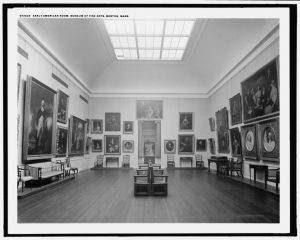
In 1893, Gilman accepted a job as a curator at the Museum of Fine Arts, Boston. He had never studied art or art history, but had done “a little cataloging” for the museum. He agonized over the offer, which he feared would mean giving up research, but took the job. He would stay at the museum for thirty-two years.16 His title and duties varied over time (curator, librarian, secretary, assistant, and acting director) but his role as intellectual authority would not. Gilman was at the center of the debates that shaped the museum and American museums more generally. He insisted on original art, not copies; on the dual system of display that put masterpieces front and center in the gallery and moved lesser quality art to the storeroom; on the importance of connoisseurship, and the unimportance of art history; and on making the visitor comfortable by introducing docents and defeating museum fatigue. He was a prolific spokesman for these ideas, publishing widely, and speaking at the American Association of Museums.17 His Museum Ideals of Purpose and Method, published in 1917, offered the fullest explanation of his beliefs about museums.
The ideas about proper viewing that Gilman offered in Museum Ideals of Purpose and Method were already present in his teaching at Clark. Shaped by the debates about attention that were the focus of the late nineteenth-century scientific psychology he had studied at Harvard, and developed through his research on music, his teaching on pain and pleasure, and his writings on aesthetics, they would in turn shape the twentieth-century art museum.
Gilman believed that museums should be about direct engagement with the art, about paying attention properly. That brings us back to the skiascope, a device that would provide the means for that proper engagement, for seeing correctly. His background in experimental psychology, with its wide use of instruments, would have made him comfortable with this kind of apparatus. His appreciation of the role of the teacher in shaping the student’s attention transferred easily to the role of the curator shaping the visitor’s attention. His philosophical belief in the importance of the viewer would make a device, such as the skiascope, a reasonable approach to solving a museum problem. It made perfect sense for Gilman to invent a device to force museum visitors to look in a “correct” way as an approach to solve the problem of viewing art in the museum.18
Gilman unveiled the skiascope at the 1917 meeting of the American Association of Museums, in New York.19 One can imagine him taking the stage—a “lean, gentle, gray-bearded scholar,”20 fastidiously dressed—skiascope in hand. He held the device to his eyes and looked through it at an imaginary painting on the opposite wall. Future museum visitors, Gilman said, would pick up a skiascope at the entrance to a gallery, and peer through it at paintings and sculptures, and see them better.
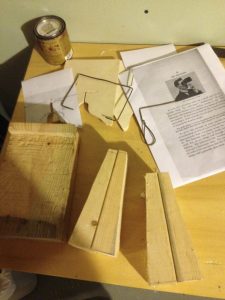
And so I built a skiascope—Gilman offers detailed directions in his book—and brought it to the RISD Museum, to the Grand Gallery, hung salon style. It is the kind of gallery Gilman would have known, with a skylight and many pictures hung close together. Gilman suggests that I would see “a noticeably deeper tone” in paintings, and “accentuated lights and shadows” on sculpture.21
When I held my skiascope to a painting, the first effects I noticed were, indeed, less glare, and greater contrast within the painting. My eyes did not need to deal with the light coming from the wall around the art, just the light reflected from the painting itself, so there was less overall contrast to which to adjust. By blocking light that is not useful, the skiascope let my eyes focus on just the light that carried meaning—the painting itself.
But even more significant was an unexpected effect. The skiascope made a painting appear to have greater depth. The skiascope includes fabric that runs down the center of the device, a septum separating the line of vision from each eye. The skiascope mostly eliminates binocular vision; it is like looking through two tubes, one for each eye. By eliminating spurious binocular clues, it offers the appearance of greater three-dimensionality in a painting.22
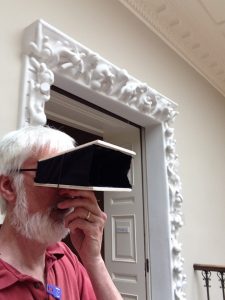
The skiascope sharpened my vision—each work of art stood by itself, framed by the rectangular opening of the skiascope. Both physically and metaphorically, the skiascope encapsulates everything Gilman thinks about museums: it blocks out all but the art. Helen Rees Leahy, in Museum Bodies: The Politics and Practices of Visiting and Viewing, notes that like many curators of his day, Gilman was concerned that visitors were not using galleries properly, that they were not paying attention, that they were not looking properly.23 The skiascope was technology that addresses that problem.
As technology, the skiascope was not a success. But the way of seeing it represented—aestheticized, focused, attentive—was. That is the story that Kathleen Curran tells in The Invention of the American Art Museum, the reason she offers a line from the 1904 essay by Gilman as the leitmotif of “the birth certificate of the modern American art museum.” Ideas about attentiveness, brought by Gilman from the psychology of James to the museum, were part of the reason for the change. So too were the German innovation of the Kulturgeschichte, and changes in the way artists wanted their art seen.24
Indeed, Andrew McClellan argues that “the chief achievement of twentieth-century museology was the refinement of viewing conditions and museum interiors so that the skiascope would not be necessary.”25 Gilman and his successors figured out ways to get skiascopic vision without giving everyone a skiascope: better lighting, a single line of paintings at eye level with space between them. Gilman foresaw this: “The future,” he wrote, “will surely approve also the arrangement of objects to enhance their individual effect instead of their collective effect.”26
Is skiascopic vision a good thing? It offers a focus on the art that brings us back to basics. Katherine Hillman, writing about Gilman’s philosophy of viewing from the point of view of a museum educator, found much to like: “So much of his theory,” she writes, “is about the connections between humanity sharing the joy art elaborates and elevates.” She approves of his valuing “the details of a work, rather than the generalities.”27
On the other hand, something is lost when we limit our interactions in the museum in this way, when it is just us and the art. The critique of the skiascope, in so far as it has been noticed at all, is that it is simply a kind of blinder.28 It is, as my experiment with it showed, rather more than that. It offers not just a narrowed vision, but an improved vision, improved in a particular way: more focused, more intense. But in limiting our appreciation of art to the merely visual, the aesthetic, what do we miss? Or, conversely, what do we gain when we view art in a more free-form way, a more social way, a way that opens up from the art to the rest of the world, a way that offers its history and context, rather than insisting that art is separate from the world?
I enjoyed my visit to the RISD Museum, skiascope in hand. In becoming Gilman’s attentive viewer, I saw new things. I understood the appeal of the device, and of the way of looking it stood for. I understood better what the transition to a modern museum might have felt like, and what was gained and lost in that transition.
Understanding the skiascope also provided new historical insight. Exhibitions at the twentieth-century museum are rooted, in part, in the scientific psychology of James, his focus on attention. Understanding Gilman’s personal history—his transition from mathematics to psychology to music to museums—helps understand how that happened. Through the skiascope, and Gilman’s life, we can understand the roots of the modern museum in a new way.
Acknowledgments
My thanks to Maureen Melton, Archives of the Museum of Fine Arts, Boston; James Stimpert, Johns Hopkins University Archives; Kathryn Brush, for her comments on an early version of this paper presented at Western University, London, Ontario; and finally, to the editors of Research Notes, for their sound advice in clarifying the ideas presented in this text.
DOI: https://doi.org/10.24926/24716839.1590
PDF: Lubar – Looking through the Skiascope
Notes:
- The first public description by Gilman of the skiascope was at the 1917 American Association of Museums annual meeting: Benjamin Ives Gilman, “The Skiascope,” Proceedings of the American Association of Museums 11 (1917): 52–54. The fullest description and the plans for building it are outlined in Benjamin Ives Gilman, Museum Ideals of Purpose and Method (Cambridge: Museum of Fine Arts, Boston, 1918), 238–48. The skiascopic device at the Göteborg Museum of Art, after which its journal, Skiascope, is named, seems to be an eyeshade, an earlier relative of the skiascope: (Skiascope 1 (2009): front cover. I wish to extend thanks to Kristoffer Arvidsson, the head of research at the museum for sharing photographs. ↵
- Kathleen Curran, The Invention of the American Art Museum: From Craft to Kulturgeschichte, 1870–1930 (Los Angeles: Getty Research Institute, 2016), 57. For Gilman’s quote, see Benjamin Ives Gilman, “On the Distinctive Purpose of Museums of Art,” in Communications to the Trustees Regarding the New Building (Boston: Privately printed by the Committee on the Museum, 1904), 46. ↵
- Gilman’s letter of application and course list are in his student file, John Hopkins University Archives, Baltimore. His early work in mathematics is described in Ahti-Veikko Pietarinen and Jean-Marie Chevalier, “The Johns Hopkins Metaphysical Club and Its Impact on the Development of the Philosophy and Methodology of Sciences in the Late 19th-Century United States” (The Commens Working Papers, 2014), http://www.commens.org/sites/default/files/working_papers/metaphysical-club-pietarinen-chevalier.pdf. The technical nature of his work with Peirce is clear from Benjamin Ives Gilman, “Operations in Relative Number with Applications to the Theory of Probabilities,” in Studies in Logic: By Members of the Johns Hopkins University, ed. Charles Sanders Peirce (Cambridge, MA: John Wilson and Son, 1883), 107–25. ↵
- C. James Goodwin, A History of Modern Psychology (New York: John Wiley and Sons, 2015), 140–54, offers an overview of the development of psychology in Gilman’s student days. On the Johns Hopkins department, see Alfred H. Fuchs, Rand B. Evans, and Christopher D. Green, “History of Psychology: Johns Hopkins’s First Professorship in Philosophy: A Critical Pivot Point in the History of American Psychology,” The American Journal of Psychology 120, no. 2 (2007): 303–23. Benjamin I. Gilman to President D. Gilman, August 19,1882, Gilman student file, JHU Archives; Benjamin I. Gilman to President D. Gilman, September 28,1883, Gilman student file, JHU Archives. Gilman alumnus card, Harvard University Archives. ↵
- A 1885 letter mentions describes him as “a rising psychologist and a good man.” See William James to Alice James, June 15, 1885; a letter of introduction to the University of Paris, where Gilman spent time, notes his “superior character and attainments.” See William James to James Mark Baldwin, February 27, 1897. James recommended Gilman for jobs at Cornell and Princeton University and described him as second only to George Santayana as “your best aesthetic man.” See William James to James Mark Baldwin, October 9, 1896 and February 27, 1897. For the James correspondence, see Ignas K. Skrupskelis, ed., The Correspondence of William James: Electronic Edition (Charlottesville, VA: InteLex, 2008). ↵
- Skrupskelis, The Correspondence of William James. See James to Charles William Eliot, July 2, 1890. Gilman and James remained friends, seeing each other at lectures and dinners in Boston and Cambridge for many years. When Charles Sanders Peirce, Gilman’s first teacher, visited James in 1903, James made sure to invite Gilman. James to Charles Sanders Peirce, December 13, 1903. ↵
- Ibid. Gilman’s correspondence with James shows the range of the field, and his interests. It covers physiology (anatomic investigations of the electrical operations of nerves, including comparisons to railroad switches), psychology (the nature of attention), and philosophy (the “direct power of the Will”),Benjamin Ives Gilman to James, June 30, 1889. ↵
- Benjamin Ives Gilman, “Report on an Experimental Test of Musical Expressiveness,” The American Journal of Psychology 4, no. 4 (1892): 558; For a summary of this work, see Emery Schubert and Dorottya Fabian, “A Taxonomy of Listeners’ Judgments of Expressiveness in Music Performance,” in Expressiveness in Music Performance: Empirical Approaches Across Styles and Cultures, eds. Dorottya Fabian, Renee Timmers, and Emery Schubert (Oxford, New York: Oxford University Press, 2014), 284. ↵
- Sue Carole DeVale, “Gilman, Benjamin Ives,” Grove Music Online, nd; Brian Hochman, “Hearing Lost, Hearing Found: George Washington Cable and the Phono-Ethnographic Ear,” American Literature 82, no. 3 (September 2010): 541; Gilman’s writings on ethnomusicology include Benjamin Ives Gilman and Jesse Walter Fewkes, Zuni Melodies (Boston: Houghton, Mifflin, 1891), 68; and Benjamin Ives Gilman, “On Some Psychological Aspects of the Chinese Musical System,” The Philosophical Review 1, no. 1 (1892): 54–78. The Columbian Exposition recordings are now in the Library of Congress. ↵
- DeVale, “Gilman, Benjamin Ives.” Also see Gilman to Ira Remson, April 17, 1890, in Gilman student file, JHU Archives; description of course in Benjamin Ives Gilman, “Syllabus of a Course of Lectures on the Psychology of Music” 1890–91, in Daniel Gilman Papers. Gilman’s student papers also contain a description of his very similar course at Colorado College. ↵
- Benjamin Ives Gilman, “Syllabus of Lectures on the Psychology of Pain and Pleasure,” The American Journal of Psychology 6, no. 1 (1893): 45, and 50–53. ↵
- William James, The Principles of Psychology, Vol. 1 (New York: Henry Holt and Company, 1890), 424. See also Jonathan Crary, “Unbinding Vision,” October 68 (Spring 1994): 21–44. ↵
- William Benjamin Carpenter, Principles of Mental Physiology, with Their Applications to the Training and Discipline of the Mind, and the Study of Its Morbid Conditions. (New York: D. Appleton and Company, 1888), 134; See also Jonathan Crary, Suspensions of Perception: Attention, Spectacle, and Modern Culture (Cambridge, MA: MIT Press, 1999), 63. ↵
- Alexandra Hui, “Sound Objects and Sound Products: Standardizing a New Culture of Listening in the First Half of the Twentieth Century,” Culture Unbound Journal of Current Cultural Research 4 (2012): 603. ↵
- Gilman, “Syllabus of Lectures on the Psychology of Pain and Pleasure,” 40–41. ↵
- Benjamin I. Gilman to Daniel Gilman, February 5 and 12, 1893, in Gilman Papers. ↵
- Gilman addressed these topics in his talks to the American Association of Museums, his memoranda to the board of the Museum of Fine Arts, Boston, and in his published writings. They are covered in detail in Gilman, Museum Ideals of Purpose and Method. ↵
- An 1893 description listed dozens devices for studying vision; its photographs showed just how experimental psychology was at Harvard: Hugo Münsterberg, Psychological Laboratory of Harvard University (Cambridge: The University, 1893). The Harvard Collection of Scientific Instruments holds many pieces of experimental apparatus from the psychology laboratory. Gilman was also an inventor, receiving patents for a matchbox, bookstand, and calendar system in the 1890s. ↵
- Gilman, “The Skiascope,” 52–54. ↵
- Walter Muir Whitehill, Museum of Fine Arts, Boston: A Centennial History (Cambridge, MA: Belknap Press, 1970), 300. Whitehill “remembered vividly for half a century” a talk by Gilman at the Museum of Fine Arts, Boston, in 1914, when Whitehill was fourteen. ↵
- Gilman, “The Skiascope,” 53. ↵
- The eye uses its binocular vision to draw clues about the relative location in space of objects in a scene. A painting, however, is flat and binocular vision therefore of no use. Indeed, many paintings are full of false information about depth, tricks of perspective that offer the illusion of three-dimensionality. The cues from the painting (in that you are seeing depth) and the cues from binocular vision (in that it is flat) report conflicting information. The skiascope eliminates cues that undermine the illusions created by the artist, allowing the eye and the brain to create a more compelling sense of depth. I wish to extend my appreciation to Dr. David M. Berson, Sidney A. Fox and Dorothea Doctors Fox Professor of Ophthalmology and Visual Sciences at Brown University, for his explanation of the science of the skiascope. William James was fascinated by binocular vision, and it is likely that Gilman would have studied the phenomenon at Harvard University. ↵
- Helen Rees Leahy, Museum Bodies: The Politics and Practices of Visiting and Viewing (Burlington, VT: Ashgate Publishing, 2012), 59–63. ↵
- Curran, The Invention of the American Art Museum; Andrew McClellan, The Art Museum from Boullée to Bilbao (Berkeley: University of California Press, 2008), 124–32. ↵
- McClellan, The Art Museum from Boullée to Bilbao, 72. ↵
- Gilman, Museum Ideals of Purpose and Method, 427. Where did all of the paintings that once filled the walls of the gallery go? In most nineteenth-century museums, everything the museum owned was on display. The curator would put the best art at eye level (“on the line”) and would “sky” the art of lesser quality, displaying it high up on the wall. In the new system, art went into a study collection, a densely-packed display of art for those who wanted to study it closely. That did not last long, and by the 1950s, most museums had put the art that did not fit on the walls of a gallery that were hung in the modern way, into storage. Today, ninety percent or more of the holdings of most art museums are in storage. Skiascopic vision requires a focus, a narrowing, not just on the part of the visitor, but on the part of the museum. ↵
- Katherine Hillman, “Benjamin Ives Gilman: Arts in People’s Lives,” in Thirteen Museum Theorists at Play: Reflections on Theory and Practice in Museum Education, ed. Jeffrey Hall et al., iBook edition, 2014, 30; also see 25–34, https://itunes.apple.com/us/book/12-museum-theorists-at-play/id869469574. Modern museum educators have mixed feelings about Gilman, appreciating his focus on the art and the viewer, but shying away from what they see as his elitist assertation that there is a “right way” to see art. See Ken Yellis, Marlene M. Robinson, and Joseph Reis, “Who Is Benjamin Ives Gilman and Why Is He Saying These Awful Things about the Way I Do My Job?,” Museum Education Roundtable Reports (Fall, 1977), 10, 18–20. https://www.jstor.org/stable/40479314?seq=1#page_scan_tab_contents ↵
- Stephen D. Arata, “Object Lessons: Reading the Museum in ‘The Golden Bowl,’” in Famous Last Words: Changes in Gender and Narrative Closure, by Alison Booth (Charlottesville: University of Virginia Press, 1993), 199–229; and Barbara E. Savedoff, “Frames,” The Journal of Aesthetics and Art Criticism 57, no. 3 (July 1999): 354–55. ↵
About the Author(s): Steven Lubar is Professor of American Studies, History, and History of Art and Architecture, Brown University.

